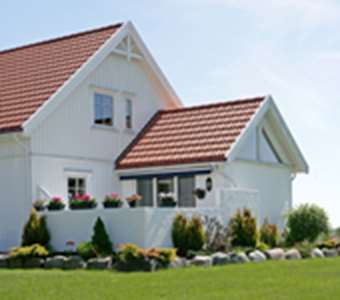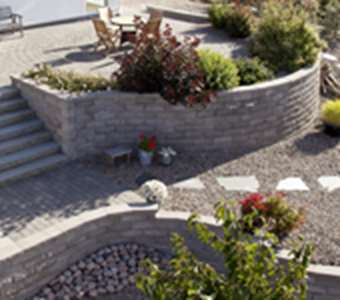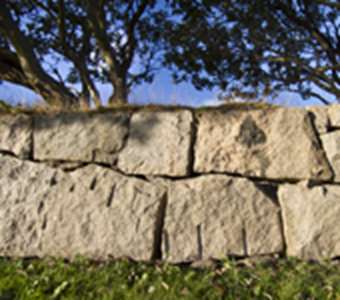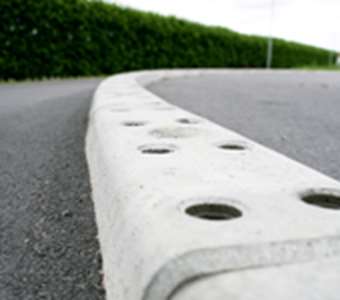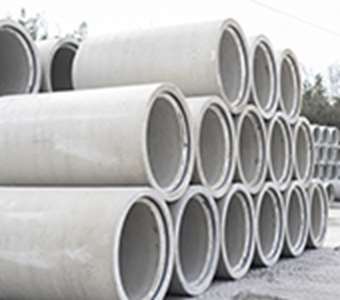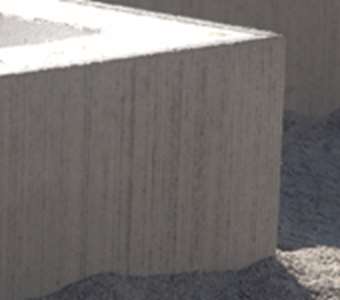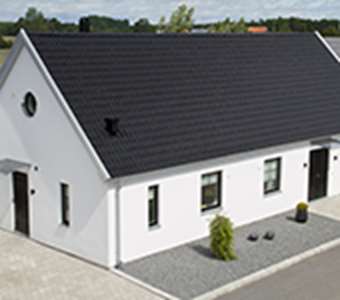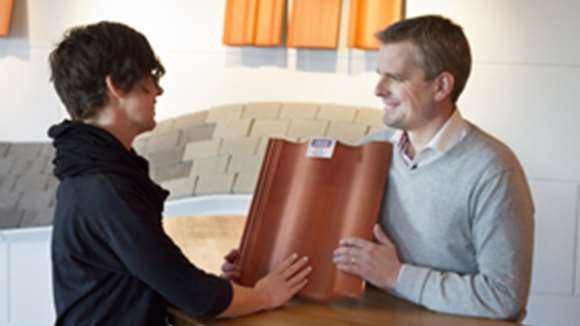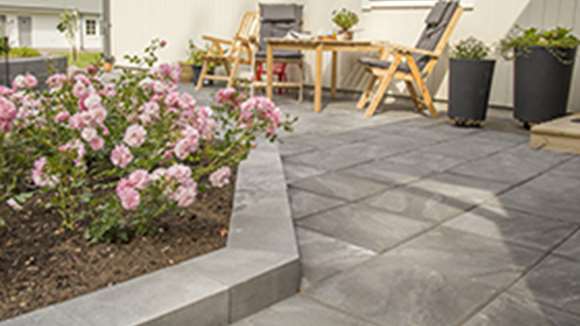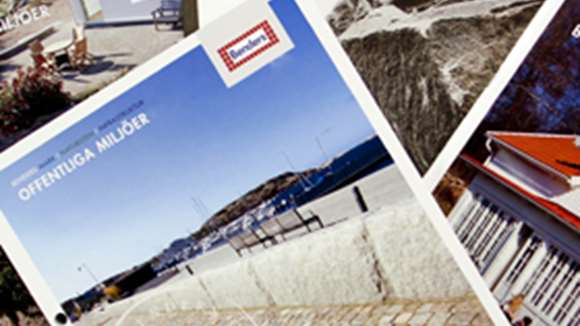HELP ME CHOOSE!
-
Where can I get inspiration?
Choosing from our vast ranges is fun and interesting, especially if you use the aids on our website.
Using our inspiration tool, you can put together various products to see how they suit the colour of your house. Our inspiration tab takes you to many potentially inspirational pictures. These show the choices made by other people and the smart solutions they have devised.
Our popular brochures give you an overview of what our ranges include. Look through these in peace and quiet and find the best solutions for you! Brochures are available from any of our knowledgeable distributors and retailers. Most of these also have wonderful displays where you can see and feel our products. Use our system for locating a distributor who is suitable for you and your needs.
-
What are the properties of the various top coatings?
A natural roof tile is made from concrete that is the same colour throughout. The colouring pigment is iron oxide. Surfaces are natural concrete and have a robust look about them. Natural roof tiles often experience natural precipitation of surface lime in their first year. This subsequently matures to give the tiles their natural colour.
A top-coated roof tile starts as one that is the same colour throughout. It is then given two coatings of Benderit. This makes it possible for you to choose concrete roof tiles in a large number of colours. Benderit is an in-house developed paint that, with the purpose of ensuring the highest quality, was specially devised for application to concrete roof tiles.
Bender Candor is a high-gloss top coating (Benderit with the addition of a clear varnish) that offers many advantages. Thanks to its greater wear resistance, it has a longer aesthetic service life. The finish is also harder and thus more resistant to the growth of moss and algae. It is a well-proven product that has become increasingly popular over the past 15 years.
Bender Brilliant is tomorrow’s top coating available today! A metal-based pigment gives a resistance that is far superior to that offered by all other concrete roof tiles manufactured up until now. The pigment in the colouring is flat and the overall result, changing with changes in light, is an unparalleled gloss and a play of colours such as you have never seen before.
Bender Struktur has a crushed stone mixed into our Benderit paint to give a granular finish. This finish means that snow stays on the roof longer and that the weight is more evenly distributed on the house. It is a favourite in areas with lots of snow.
-
How long does a concrete-tile roof last?
Very long – the normal service life of Benders’ concrete roof tiles has been calculated at over 100 years.
HOW MANY DO I NEED?
-
How many roof tiles do I need for my roof?
Broadly speaking, you need 9 Palema tiles per m2 of roof surface. For shallow roof pitches or when using other roof tiles, the quantity increases slightly. In our user instructions for each roof tile, there are exact instructions on how to calculate the number of roof tiles in each case. You can even use our roof calculation tool. Simply enter some basic measurements and you will get a complete suggestion for roof tiles and relevant accessories.
-
How many snow hooks do I need?
Use the NOMO calculator for this. It will not only help you calculate how many you need, it will also suggest a laying pattern.
-
How many litres are there in an 800 kg sack?
The density of the material varies. It can generally be said that an 800 kg sack holds around 500 litres of decorative material.
-
How much joint filler do I need for my paving stones and/or slabs?
Use our joint filler calculator to calculate how much filler you need for your paving.
HOW AND WHERE CAN I BUY?
-
How and where can I buy your products?
All sales are via our distributors/retailers. In Sweden, most building materials outlets stock our ranges. To find a suitable outlet, you can use Locate distributor on our website. This will show your nearest stockists.
HOW ARE DELIVERIES MADE?
-
How are your products delivered?
Our most widely used products (e.g. Palema Tegelröd and Labyrint Antik Grå) are held in stock by our distributors. They can be either delivered or collected from the outlet. Goods ordered from Benders’ own warehouses can be sent to a retail outlet or direct to the end customer at the building site. At the building site, goods are unloaded onto the ground or, for an additional charge, lifted onto the roof.
HOW DO I USE YOUR PRODUCTS?
-
The joint’s importance
When you lay paving stones and/or slabs, it is easy to forget the joints and their importance. Joint filler serves to lock what you lay and reduce the growth of weeds between stones/slabs. A well-filled joint between stones/slabs is important not just aesthetically. It also has several important technical functions.
When a surface that has been laid with paving stones or slab is subjected to a load, force is transferred across the stones/slabs via the joints. This is why it is important that joints are well-filled with joint filler so that the forces are transferred in the correct way. If the joints are insufficiently filled or too narrow, there is a risk of the stones/slabs banging against each other. This can damage the edges of the stones/slabs.
A too wide joint that is not stabilised by well-executed ground preparation and edge guards can result in forces being transferred incorrectly. This is why we recommend a 3 mm joint for paving stones and slabs.
When you have laid and jointed your stones/slabs, you can advantageously leave excess joint filler on the surface for a time. Rain and wind will gradually wash it down into the joints. After some time, it may also be necessary to refill the joints so that they still work as they should. Benders offers three different sorts of joint filler in several different colours. See Joint filler, Lithomex Easy and Lithomex L20.
-
I’m considering replacing my roof myself. Where can I get information about how to do this?
There are complete user instructions on the product page for each roof tile. User instructions and product information for individual roofing accessories (ridge and hip roll, ventilation hoods, snow guards, etc.) are also available there. These can additionally be found via “Documents”.
-
How much fastening of roof tiles to the subroof is necessary?
Both outermost rows of tiles around the whole roof as well as tiles around inlets/outlets, skylights, chimneys, etc. must always be fastened. Use Benders’ stainless steel nails, screws or clips. Where a roof is particularly exposed to weather, the use of clips is even recommended for Palema. Bender Exklusiv can only be fastened with clips.
With roof pitches over 45° and where there is particular exposure to weather, fastening must be more frequent (every 5th tile). With pitches steeper than 55°, all roof tiles must be fastened.
I NEED SOME TIPS ON CARE!
-
How do I remove moss from roof tiles?
Generally speaking, concrete roofing needs little or no maintenance. Depending on location and surroundings, moss and algae can grow on almost anything. A northern aspect is always more prone than is a southern. Nearby large trees can promote growth. One good way of keeping a roof clean and attractive is to use Bender Tak och Markrent (Benders’ roof and stone/slab cleaner). This is applied using a pressure hose. The rain then takes care of the rest. Our cleaning agent kills both moss and algae. The treatment should be repeated every four years. You can download the product data sheet for Bender Tak och Markrent here (PDF, 214 kB).
-
How do I take care of my paved surfaces?
For care instructions, see Care of paving stones and slabs.
-
How do I deal with moss, fungus and algae on my paved surfaces?
The paving of patios, paths and garage drives can, in certain cases, acquire a covering of algae, fungus or moss. For care instructions, see Care of paving stones and slabs.
-
Can I use salt on my paved surfaces?
Benders does not recommend salting. It can result in corrosion of concrete surfaces. The stones/slabs are then more porous and brittle. We recommend gritting sand (Bender halksand), which can be found in our ranges. For further details, see Care of paving stones and slabs (PDF document, 300 kB).
WHAT GUARANTEES DOES BENDERS GIVE?
-
What guarantees do you give for roof tiles?
Benders Sverige AB is liable for strength, watertightness and frost resistance for ten years.
When you use original accessories and fit the roof in accordance with the relevant instructions and rules, we can give a 30-year guarantee on our products.
THIS IS HOW!
-
4 kN or 20 kN?
An L-retaining element rating of 4 kN or 20 kN means that the horizontal ground surface at the level of the crown of the L-retaining element’s upright can be loaded with, respectively, 4 kN/m² or 20 kN/m².
In practice, this means that the ground above a 4 kN L-retaining element can only take the load presented by snow and people. It can also take a small ride-on mower, but vehicle loads are not allowed.
A 20 kN L-retaining element can take the weight of private cars provided that the cars park some metres away from the crown of the L-retaining element’s upright. If the ground surface slopes upwards from the crown of the L-retaining element’s upright, a 20 kN/m² rating is always required.
-
How are Bender cobblestones size graded?
Benders offers two different sacks of cobblestones. In one of these, cobblestone size is 70 – 100 mm. In the other it is 100 – 250 mm. Cobblestones are size graded in machines. The stones are screened through large meshes that separate the different sizes. Because the cobblestones are not totally round and are a product taken from nature, sizes can vary.
The design of the meshes means that stones can fall through if any one side matches the size criteria above. Thus, depending on stone shape (dimensions), sacks may contain different grades.
-
What is the difference between the construction dimensions and the product dimensions of paving stones and slabs?
Paving stone and slab construction dimensions are what we give in our product catalogues and on our website. The construction dimensions are vital when planning (or laying) an area that is to have paving stones and/or slabs. This is because these dimensions include the recommended joint width of 3 mm.
Product dimensions are the paving stone’s or slab’s real length and width excluding any spacing. The product dimensions are not given in any of our product catalogues or on our website. They are not useful when planning (or laying) an area that is to have paving stones and/or slabs. The tolerance requirements in Swedish standards are in relation to product dimensions.
-
Why has my Lithomex Easy not hardened?
When you lay paving stones and/or slabs, it is easy to forget the joints and their importance. The joints between the stones/slabs are important not just aesthetically. They also have several important technical functions. Joints play a major role in achieving good results (exactly the same as do the choice of stones/slabs and correctly executed ground preparation). Depending on which joint filler is chosen, laying requirements differ.
When using an elastic filler (where the hardener is activated by water), it is critical that laying is carried out exactly as per the instructions. Read the packaging meticulously and check the installation film.
When an elastic filler does not harden correctly, it is most usually because of one or more of the following:
- Joints too wide. Lithomex Easy cannot be used for joints wider than 10 mm.
- Not enough water. As shown in the installation film, a lot of water must be used. The entire joint must be completely soaked.
- Sack contents were not mixed. During sack transport, the sand and hardener can settle into distinct layers. Thus, always mix sack contents once again before laying begins.
- The substrate does not drain. Joints let water through. This water must be able to drain away. Water must not be allowed to collect in the joint. If the water does not drain away, the joint will not harden. Instead, there is a risk that the joint will swell or become sticky when there is rain. Thus, Lithomex Easy cannot be used for laying where the superstructure retains water. Note that a far too thick (over 30 mm) course of 0-4 stone dust in the bedding layer can be too dense and not drain sufficiently well. This may result in the joint not hardening.














